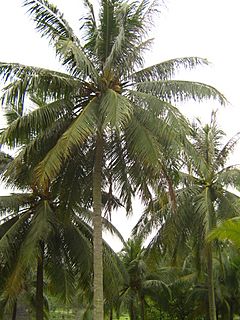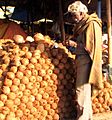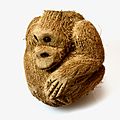Coconut palm facts for kids
Quick facts for kids Coconut |
|
|---|---|
 |
|
| Coconut palm (Cocos nucifera) | |
| Scientific classification | |
| Kingdom: | |
| Division: | |
| Class: | |
| Order: | |
| Family: | |
| Genus: |
Cocos
|
| Binomial name | |
| Cocos nucifera |
|
The coconut palm is a palm tree in the family Arecaceae (palm family). It is a large palm, growing to 30 m tall. It has leaves that are 4–6 m long. The term coconut refers to the fruit of the coconut palm. The coconut tree is a monocot.
There are many coconut palms on the coasts of India and Bangladesh. People of this area use coconut milk in cooking. Women use coconut oil as oil for their hair. The coconut's shell is relatively hard, but can be broken. Because its shell is hard, it can be used as an ingredient to make craftworks.
Coconut milk is also used in many drinks. Coconut oil is often in food and soaps. People in Sri Lanka use coconut flowers for wedding celebrations. In the Maldives it is the National tree.
A coconut is a large nut. Coconuts grow in tropical countries. The flesh of a coconut is white and can be eaten raw or used in cooking. It is used in many of the foods we eat for flavour. It is native to tropical areas.
Seed dispersal

Coconuts floats on water and can float to another island and germinate there. It has often been noted that coconuts can travel 110 days, or 3000 miles, by sea and still be able to germinate.
Images for kids
-
Fossil "Cocos" zeylanica from the Miocene of New Zealand, approximately the size of a strawberry at 3.5 cm (1+1⁄2 in) long
-
Chronological dispersal of Austronesian peoples across the Indo-Pacific
-
A wa'a kaulua (double-hulled canoe) from Hawai'i. Catamarans were one of the early technological innovations of Austronesian peoples that allowed them to colonize the islands of the Indo-Pacific and introduce coconuts and other canoe plants along their migration routes.
-
Palms tolerate the saline and infertile soils of laterite type in Goa, India
-
Coconut trees on a beach in Upolu, Samoa
-
Coconut germinating on Punaluʻu Beach on the island of Hawaiʻi
-
The Pacific flying fox (Pteropus tonganus) feeding on nectar and pollen from coconut flowers in Fiji
-
Red nata de coco in syrup from the Philippines
-
Macapuno preserves sold in the United States
-
Coconut trees line the beaches and corniches of Oman
-
Immature green coconuts sold in Bangladesh for coconut water and their soft jelly-like flesh
-
Coconut milk, a widely used ingredient in the cuisines of regions where coconuts are native
-
Coconut water drink
-
Ubod (coconut heart of palm) from the Philippines
-
Bahalina, a traditional coconut wine (tubâ) from the Philippines fermented from coconut sap and mangrove bark extracts
-
Coconut buttons in Dongjiao Town, Hainan, China
-
Extracting coir, the fiber from the coconut husk, in Sri Lanka
-
Pusô, woven pouches of rice in various designs from the Philippines
-
Palaspas, woven palm fronds during Palm Sunday celebrations in the Philippines
-
A "coconut monkey" from Mexico, a common souvenir carved from coconut shells
See also
 In Spanish: Palma cocotera para niños
In Spanish: Palma cocotera para niños
































